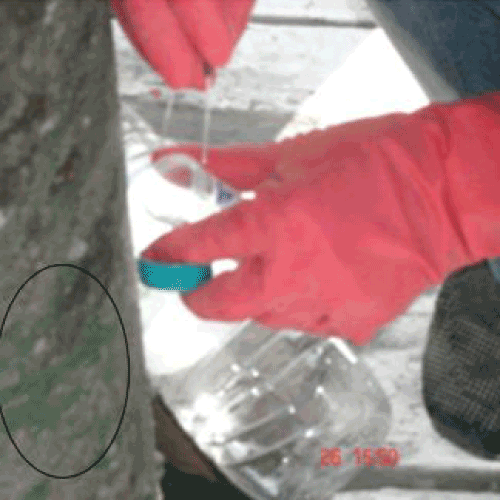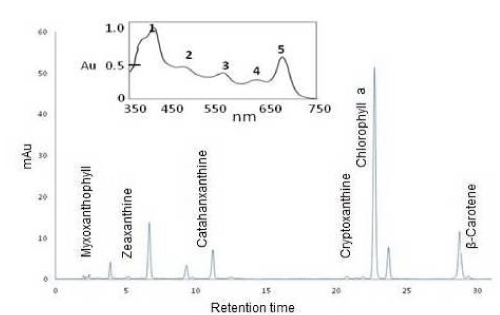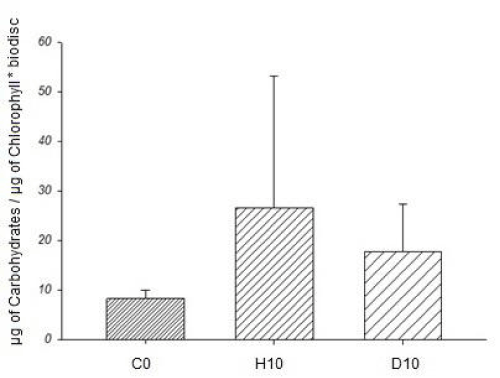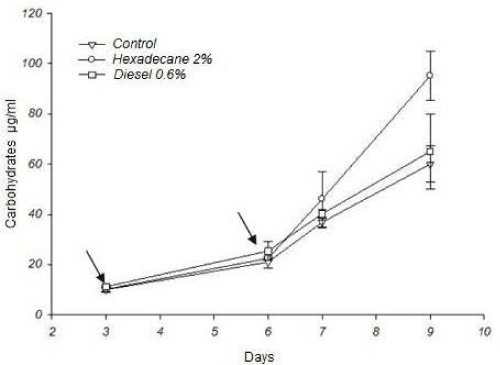Special Issue Article Open Access
Bioremediation of Hexadecane and Diesel Oil is Enhanced by Photosynthetically Produced Marine Biosurfactants
| Alberto Rosales Morales, Paniagua-Michel J* | |
| Department of Marine Biotechnology, Center of Scientific Research and Higher Education from Ensenada, Mexico | |
| Corresponding Author : | Paniagua-Michel J Department of Marine Biotechnology Center of Scientific Research and Higher Education from Ensenada, Mexico Tel: 526461750500 E-mail: jpaniagu@cicese.mx |
| Received November 23, 2013; Accepted January 04, 2014; Published January 10, 2014 | |
| Citation: Morales AR, Paniagua-Michel J (2013) Bioremediation of Hexadecane and Diesel Oil is Enhanced by Photosynthetically Produced Marine Biosurfactants. J Bioremed Biodeg S4:005. doi:10.4172/2155-6199.S4-005 | |
| Copyright: © 2014 Morales AR, et al. This is an open-access article distributed under the terms of the Creative Commons Attribution License, which permits unrestricted use, distribution, and reproduction in any medium, provided the original author and source are credited. | |
Related article at Pubmed Pubmed  Scholar Google Scholar Google |
|
Visit for more related articles at Journal of Bioremediation & Biodegradation
Abstract
In the coastal environment of the Todos Santos Bay (Ensenada BC, Mexico), the sport fishing dock is chronically polluted due to frequent anthropogenic activity. The presences of aliphatic hydrocarbons in surface hydrocarbon-rich wastewater from this Bay reflect the differences in industrial and domestic pollutant activities. In this research, the bioprospection and screening of indigenous microbial mats led to the isolation of a strain of Phormidium sp. able to produce marine surface-active biosurfactants, which in turn contributed to bioremediate the levels of hexadecane and diesel. Field studies could corroborate the bioremediation potential of this strain. Our studies demonstrated that the marine cyanobacteria Phormidium sp. remove hexadecane (45%) and diesel oil (37%) from aqueous phase when grown in real seawater enriched with nutrients and in presence of these hydrocarbons within 10 days. The partially purified surface-active agents produced by Phormidium biodisk contributed to enhance the removal potential of this strain for hexadecane and diesel. In axenic cultures, the monospecific cyanobacterium Phormidium structured in biodisks mats exhibited degradative capacity on hydrocarbons in the range of C10–C28 carbon atom number in autotrophic conditions.
The photoautotrophic growth of the biodisks of Phormidium has been registered by the presence of photosynthetically produced pigments markers, which partially are genre specific features, viz, phycocyanine, phycoerythrin as well as zeaxanthin and other important carotenoids and chlorophylls. Moreover, photosynthetically produced oxygen is believed played an important role in biodegradation of hexadecane and diesel oil. The obtained results indicate, a high removal potential of Phormidium and an environmental safe alternative for mitigating oil pollution seashores, by the joint action of photosynthetically produced exopolysaccharides type biosurfactants.
| Keywords |
| Hexadecane; Diesel; Cyanobacteria; Phormidium; Microbial biodisks; Biosurfactants; Bioremediation |
| Introduction |
| The increased discharge of petroleum hydrocarbons (PH) in marine areas, as diesel, crude oil and some distillates, is a major global concern, due to their toxic effects in fragile and sensitive environments of these areas [1].The Sport Fishing Harbor of the Todos Santos Bay, Ensenada BC, Mexico (31° 56.5’ N, 116° 33.4’ W), is chronically polluted due to frequent anthropogenic activity. This Bay has a total extension of approx. 24,090 Ha and opens in the Coast of the Pacific Ocean, approx 130 Km south between Mexico and USA. The presences of aliphatic hydrocarbons in surface hydrocarbon-rich wastewater from this Bay reflect the differences in industrial and domestic pollutant activities. The available physical and chemical strategies commonly used to minimize these effects tend to be over expensive, and in most cases, generate further pollution. In order to have clean and less expensive technologies to restore contaminated marine environment, the bioremediation is one of the preferred approaches, because it is simple to maintain, eco-friendly, cost-effective and may leads to the complete or partial removal of the pollutants [2]. The need for an affordable and practical technology to bioremediate PH in marine environments, has lead us to the assessment of the role and advantages of Cyanobacteria over other microorganisms in terms of adaptability, growth modes (autotrophic, heterotrophic or mixotrophic). These advantages place Cyanobacteria as one of the best options to degrade organic pollutants in marine environments [3]. Moreover, it has been recognized that microorganisms grow better when they are immobilized in a support matrix than freely suspended [4,5]. In spite of the recognized benefits of immobilized Cyanobacteria, there is scarce information concerning the uses of constructed Cyanobacteria mats for the biodegradation and removal of petroleum hydrocarbons. The role of cyanobacteria using natural microbial mats in the bioremediation of PH is not clear, authors have attributed the removal of hydrocarbons to primarily by aerobic heterotrophic bacteria [6-8]. When monospecific filamentous Cyanobacteria are challenged with different PH, the results turn to be contradictory, that is some studies found that these species remove efficiently alkanes and Polycyclic Aromatics Hydrocarbons (PAH) [9-11], while others studies found that they do not have a direct role in the removal of PH [12]. It is envisioned that the immobilization of microorganisms in natural and synthetic polymers can avoid these disadvantages, because provide protection from environmental stress and avoids toxic effects of pollutants [13], also they contribute to the expression of metabolites like ExoPolysaccharides [1]. Recently renewed interest in the natural production of ExoPolysachariddes (EPS) exhibiting surfactant properties has emerged as a mean to increase the solubility of HP and hence facilitating their bioremediation. |
| In the present work, we have studied the bioremediation abilities for PH, specifically Hexadecane and Diesel removal by constructed mats of a strain of Phormidium sp. isolated from an oil-polluted coastal harbor, located in Todos Santos Bay (Ensenada BC, Mexico). The concomitant role of exopolysaccharides with surfactant properties produced by the Phormidium mat in response to these pollutants and in hydrocarbon removal was also characterized and assessed. |
| Materials and Methods |
| Oily seawater and sample collection |
| The oily seawater containing diesel, hexadecane as well as PAHs was collected from a recreational and sport fishing Harbor of the Northwestern Pacific Coast (31°56.5’N, 116°33.4’W). This water was also used for growth media elaboration in the screening experiments, unless otherwise specified. Biological samples for the isolation of the hydrocarbons degrading Cyanobacteria, were obtained from scrapings on the sub-exposed surfaces of cement columns within the Bay harboring attached biomass as evidenced by the brown-green coloration developments (Figure 1). |
| Preliminary screening of strains |
| Presumptive screening and domestication tests were developed by subjecting the collected biological samples to a growth media containing petroleum hydrocarbons from the collected oily seawater. Strains exhibiting highly degradative properties were screened-out and incubated at 25°C, finally the development of green colonies suggest that the strain can degrade oil. |
| Secondary screening of strains |
| Cyanobacteria isolation was performed by subjecting the sample for five minutes to sonication in order to clean-out the attached microorganisms to the Cyanobacteria filaments [11]. Once obtained, filaments were grown in ASN III media [14] supplemented with 10 mM Tris HCl, having pH 7.5 and salinity 32 ppt. Axenic conditions and to prevent eukaryotic growth in general, the following antibiotic solutions were applied: Penicillin (10 mg), streptomycin (10 mg) and anphotericine B (.025 mg), Nistatina 2.4 mg/L in 0.9% NaCl; Sigma). The obtained mono specific filaments were subjected to a secondary screening based on their ability to degraded increased amounts of PAHs, diesel or hexadecane contained in the media. Strains cultures were carried out in 250 ml flasks containing 100 ml of medium and incubated on an orbital shaker (160 rpm), at 25°C, for 10 days. At the same time, the OD550 was measured every 24 hours. Continuous light was provided by 4 watts fluorescent lamps emitting intensities around 150 MicroEinstein/m2/sec and 25°C. |
| Characterization of the selected isolate |
| The sampled biological material was characterized using phenotypic and taxonomic criteria of selected strains. According to the registered characteristics, the Cyanobacteria isolated strain was identified as belonging to the Genus Phormidium sp. from coastal and temperate marine habitats. In order to restrict the growth of eukaryotes, Cycloheximide was added to the growth media as recommended by Chavan and Mukherji [12]. |
| Photosynthetic pigments |
| Exponential–phase cells were used for determination of phycobiliprotein absorption spectra. An aliquot of 2–4 ml culture was centrifuged at 14000 rpm for 5 min at room temperature. The pellet was suspended in buffer consisting of: 50mM Tris/HCl (pH 8), 250 mM NaCl and 10 mM EDTA and the cells were broken ultrasonically at a frequency of 28 kHZ [15]. The absorbance of the supernatant was measured from 400 to 750 nm at Hewlett-Packard 8453, diode array spectrophotometer. HPLC of chlorophyll and carotenoids was followed according to Brotas and Plante Cuny [16] at Hewlet Packard (Agilent) 1100 using an Eclipse XDB-C8 column. |
| Construction of the Cyanobacterial mat |
| Biodisks of phormidium sp. were constructed on circular surfaces of polyester of low density (2.5 x 5 cm diameter) by adding 1 ml of 0.5 optical density of Phormidium culture on each polyester disk. Polyester was chosen for immobilization of this Cyanobacterial mat because of its fibrous structure and previous positive results with other microbial immobilized cultures [4,5,17]. Control mats were constructed using uninoculated polyester disks. Batch cultures of with 150 ml modified ASIII media were performed with the constructed biodisks (3 disks by flasks), and were exposed at continuous light intensities of 150 MicroEinstein/m2/sec and 25°C. |
| Biodegradation tests and growth kinetics with hexadecane and diesel |
| Batch cultures containing different challenging concentrations of hexadecane and diesel were tested respectively in ASN III medium and natural seawater previously sterilized. The constructed Phormidium disks were exposed to the following concentrations of Hexadecane and diesel respectively (%): 0.3 and 0.5 (v/v) during 10 days. Incubation trails were carried-out in 250 ml Flasks under the following conditions: temperature, 25°C; stirring speed, 500 r.p.m. pH was recorded but not regulated. Experiments were run in triplicate. |
| Extracellular polysaccharides characterization |
| By definition, ExoPolysaccharides (EPS) are composed by almost 90% carbohydrates [18,19], that is why these molecules were used for EPS quantification. Five milliliters of biomass were obtained by draining and squeezing each disk. After ethanol extraction, the carbohydrate content was measured according to the phenol-sulfuric acid method using glucose (99%) as standard [20]. |
| Hydrocarbon analysis |
| Field samples: Surface coastal seawater was collected on October 2012 at four previously selected sites. Three samples of polluted seawater (1L) were collected using glass amber bottles; in order to preserve hydrocarbons in sampled water, pH was fixed to 2 using H2SO4 and kept at 4°C until analysis. |
| Analysis of bioassays: Gas chromatography of control (uninoculated supports in flasks) and experimental Phormidium disks were incubated to their respective PH (Hexadecane and diesel) and were analyzed as indicated by USEPA protocols. Hexane (HPLC grade) was used to extract hexadecane and the diesel fraction (EPA method 3510C), after evaporation of the extracts in a Turbo vap (Zymark®). The samples were concentrated under a nitrogen flow, finally, the samples were injected into a capillary column of silica gel and 5% methyl silicone (30 m×0.53 mm)of a gas chromatograph (Agilent technologies 6,890) coupled to an Agilent mass detector 5973N (EPA method 8015B). |
| Emulsification index (E24) |
| Emulsification index of culture samples was determined after according to the ability of the exopolysaccharide produced by Phormidium to maintain at least 50% of the original emulsion volume for 24 h [21]. Two ml of cell-free supernatants were collected by centrifugation and added to two ml of the following hydrocarbons sources respectively: hexadecane (1%, v/v), olive oil (1%, v/v), fish oil (1%, v/v), and motor oil (1%, v/v). After mixing with a vortex for 2 min, the height of emulsion layer was determined after 24 h. The equation of was used to determine the emulsification index (E24 %): |
| E24=E/E´X 100 |
| With E: The length of the emulsified layer, and E’: The total length of the mixture [22]. |
| Degradation test and Bioremediation Index |
| Degradation of hydrocarbons in cultures was tested by gravimetric and gas chromatographic methods. For gravimetric analysis, the difference in weight between experimental conditions and control cultures was calculated as a loss in weight due to degradation. Loss in weight due to adsorption or uptake by Cyanobacteria cultures was calculated by difference in weight between control uninoculated disk. Degradation was calculated by difference in the total area of the peaks between uninoculated control and the experimental culture extracts and from the gas chromatography analysis. Hexadecane and diesel range of hydrocarbon organics was measured by comparison of a sample chromatogram previously calibrated with hexadecane and diesel oil respectively. The bioremediation index was assessed as the percentage of the ratio between control and experimental conditions with respective petroleum hydrocarbon (PH) with and without biomass (control), unless otherwise indicated. The biodegradation index was calculated according to the following expression: |
| Biodegradation (%) = [(PH control – PH treatment) / PH control] * 100. |
| Statistical analysis |
| Parameters describing the growth kinetics obtained indifferent conditions were compared using analysis of variance. |
| Results and Discussion |
| The analysis of samples of wastewater from the bioprospected harbor is shown in Table 1, which reflected the polluted origin of the site and the successful sampling of epilythic microbial mats. The mean fractions analysis of the petroleum hydrocarbons in the place evidenced a trend for compounds having carbon numbers higher than 16 which corresponded to diesel and car engine oil. The analysis of the taxonomic characteristics and the pigment profile analysis of the isolated strain allowed identifying phycocyanin and phycoerytrin as well as zeaxanthin and canthaxanthin (Figure 2), which are present in cyanobacteria, and specifically in the Oscillatoriaceae [15]. The substrate utilization test, associated to other analysis, contributed to the identification at the genre level as member of the Oscillatoriaceae nonheterocystic, Phormidium sp. Analysis of the 16S rRNA is currently underway in order to assign phylogenetic and specific classification. |
| The hydrocarbon test affected less to Phormidium when is immobilized than in free forms. Immobilization as a natural or artificial process impede to live cells to move freely through the liquid phase [23], but confers cells with advantages as the exerted action in the constructed Phormidium biodisks undertaken in this work. In general terms, this technique shows several advantages contrary to its free counterparts, as higher biomass production, and higher resistance to toxic agents [13]. The selected support, polyester carrier of low density, allows a great surface for cell colonization, as well as facilitates biomass extraction. Moreover, a high hydrophobicity, which favors cell growth simultaneously to its benthic/settling preference have been previously recognized for this kind of support by Koziar and Yamazaki [24]. In this research, Phormidium sp., exhibited a major production of exopolysaccharides and in minor degree on the biodegradation of hexadecane and diesel oil (Figures 3 and 4). The joint action of biodegradation of hexadecane and diesel oil with exopolisaccharides (surfactants) production by Phormidium was determinant as reflected in the obtained results (Figure 4). Among the factors associated to the production of surfactants (EPS) in this strain of Phormidium, we can mentioned, culture age, high salinity, and excess of nitrate and phosphate, as well as photosynthetic activity, as evidenced from the pigment profile registered in this research (Figure 2) which contributed in the emission of oxygen. These factors have been previously reported as directly involved in the increase of the production of exopolysaccharides in these genera [25,26]. In this research, maximal levels of 150.62 μg/ ml, of hexadecane 1%, were achieved in ten days. Phormidium was more sensitive to diesel (0.3%) after five days of incubation (Table 2). According to environmental stresses induce changes in the EPS biosurfactants composition, but higher concentrations do not assure emulsifying/biosurfactant functionality [27]. |
| Indeed, our work is original because in most of the studies, EPS induction have been performed by physic-chemical factors and not with the use of the same pollutants intended to bioremediate (hexadecane) as in our present work. According to in marine microorganisms, yields and active properties of surfaces are higher than in terrestrials species, an issue corroborated in our research [28] (Figures 3 and 4). The construction of biodisk from autochthonous Phormidium sp. and its induction to the production of exopolisaccharides with emulsifying/ biosurfactant properties achieved by petroleum hydrocarbons, viz, hexadecane and diesel oil, holds a great practical potential for petroleum hydrocarbons bioremediation in coastal-marine environments. The photosynthetic production of biosurfactants in seawater also is a great advantage for fragile and sensitive environments as well as for conservation issues of biodiversity rich marine environments exposed to frequent and chronique pollution of petroleum hydrocarbons. |
| This is the first work on the isolation, characterization and assessment of marine microorganisms of Todos Santos Bay (Ensenada BC México) able to produce biosurfactants by photosynthetically renewable biomass of marine cyanobacteria coupled to the bioremediation of petroleum hydrocarbons. These EPS biosurfactants in joint action with the attributes of Phormidium, contributed into the biodegradation and bioremediation of hexadecane and diesel oil, which was corroborated by the emulsifying/surfactant capacity of the EPS produced by this strain. The emulsification index (E24) applied in the cells tested, was higher than 50% in motor oil, fish and olive oil and less in Hexadecane. The results reflected the contribution of biosurfactants in the expected possibilities occurring between the pollutants and the environment, viz, (a) the interfacial tension water-air exerted by the activity of EPS (biosurfactants) and photosynthetically emitted oxygen, (2) the interaction between immiscible liquids or (3) in the interfaces solid-liquid (bioemulsificants).The aerobic conditions of growth of Phormidium and complemented by its photosynthetic activity, in turn supply the oxygen that facilitate the degradation of the petroleum hydrocarbons [3], a condition that is enhanced by its metabolic production of biosurfactants. As an indigenous organism, Phormidium biomass can be produced in local conditions using nutrients from marine wastewater and sun illumination, which is also highly promissory for the production of low-cost and green biosurfactants-emulsifiers (from Cyanobacterial origin) and coupled to other productive recycling bioprocesses such as biofuels and wastewater bioremediation. These industrial bioprocesses are environmentally sustainable facing the end of the fossil based economy era and a new world bio-based economy era based on renewable resources. Emphasis is placed in these latter strategies on the uniqueness of municipal wastewater treatment sludges both to produce a cost competitive biosurfactant and to offset the costs of high quality wastewater treatment. Actual production of biosurfactants must compete with the chemical-petrochemical surfactants, mainly in cost, yield and functionality. High production cost can be achieved for biosurfactants production in the new generation of industrial hybrid bioreactors, assuming the right strain is isolated. On the other hand, value added and high-priced products can be accepted if biosurfactants are used in low-volume (e.g. cosmetics, medicinal, etc.). Presently, probably the high production costs still deserves to be overcome in order to be compatible with those applications (e.g. enhanced oil recovery) which require high volumes of low-priced surfactants [29]. It is expected that sustainable production of biosurfactants could be achieved combining the developments in biotechnology and bioengineering of algal biomass, such as the reduction of biosurfactants production costs, the process and the growth substrates as well as the by-products (saleable products rather than wasted). |
| Acknowledgements |
| The authors wish to acknowledge the financial support provided by the Fondo sectorial de investigacion en Salud y seguridad social SSA/ IMSS/ISSSTE-CONACYT, through the project C01-69968, granted to J. Paniagua Michel. |
References
|
Tables and Figures at a glance
| Table 1 | Table 2 |
Figures at a glance
 |
 |
 |
 |
| Figure 1 | Figure 2 | Figure 3 | Figure 4 |
Relevant Topics
- Anaerobic Biodegradation
- Biodegradable Balloons
- Biodegradable Confetti
- Biodegradable Diapers
- Biodegradable Plastics
- Biodegradable Sunscreen
- Biodegradation
- Bioremediation Bacteria
- Bioremediation Oil Spills
- Bioremediation Plants
- Bioremediation Products
- Ex Situ Bioremediation
- Heavy Metal Bioremediation
- In Situ Bioremediation
- Mycoremediation
- Non Biodegradable
- Phytoremediation
- Sewage Water Treatment
- Soil Bioremediation
- Types of Upwelling
- Waste Degredation
- Xenobiotics
Recommended Journals
Article Tools
Article Usage
- Total views: 14670
- [From(publication date):
specialissue-2014 - Jul 03, 2025] - Breakdown by view type
- HTML page views : 10020
- PDF downloads : 4650
